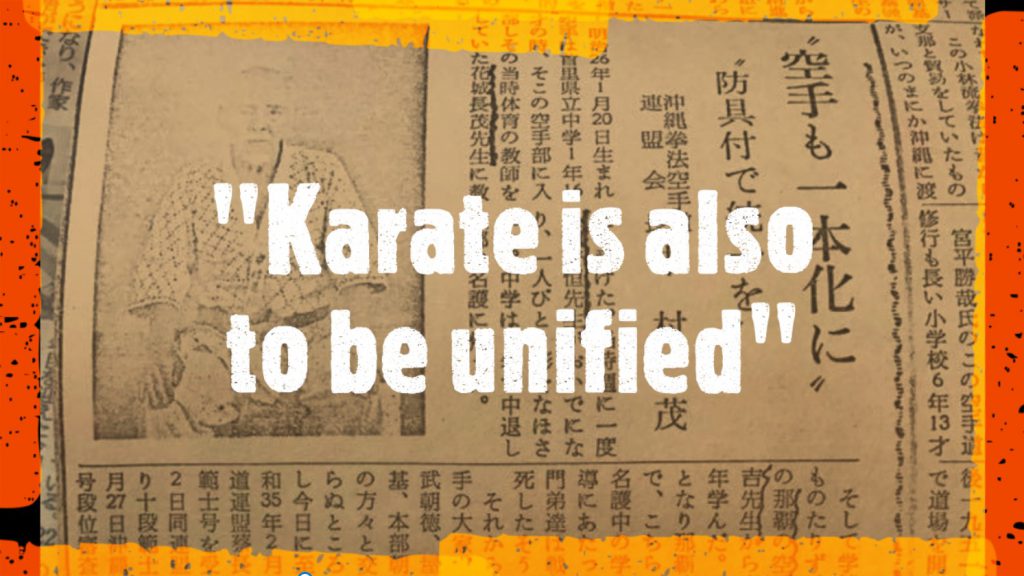“Karate is also to be unified”
“Unification with wearing protective gear”
Nakamura Shigeru, Chairman of the Okinawa Kenpō Karate-dō Renmei
Born on January 20, 1893, he entered the Karate Club of the Shuri Prefectural Middle School in Shuri at the age of 16 years [1909] and was taught by Hanashiro Chōmo, a physical education schoolteacher at the time. At that time, Itosu Ankō Sensei came once a week and corrected each persons’ kata. He dropped out of Middle School in his 3rd year [1911] and returned to his hometown of Nago.
He did not do much at the school karate club, but in Miyazato Village (Nago) he studied professionally for 10 years consecutively with Bushi Shinkichi Kuniyoshi Sensei of Naha karate. Since [Kuniyoshi] sensei returned to Naha at an old age, he had a dōjō here in Nago, were he taught school students and young men. However, these disciples were almost all killed in the war [Battle of Okinawa].
After that, he [Nakamura] went to Shuri and Naha and met karate experts such as Miyagi Chōjun, Kyan Chōtoku, Yabu Kentsū, Motobu Chōki, and Motobu Chōyū, and continued supplemental study by himself until today. Further, on February 5, 1960, [Nakamura] Sensei received the title of 10. Dan Hanshi from Sai Chōkō, chairman of the All Japan Karate Federation (the original JKF), and on June 2, 1963, he received the title of 10. Dan Hanshi from the third council of the same federation, and on February 27, 1966, he received the title of Hanshi from the examination committee of titles and dan ranks of the Okinawa Kobudō Kyōkai (later reorganized into Zen Okinawa Karate Kobudō Rengōkai in 1967). Also, in 1961 he became a member of the board of directors of the Okinawa Kobudō Kyōkai. He also received a letter of appreciation from the Commission for Protection of Cultural Properties of the Government of the Ryukyu Islands (1952-1972). In 1967, he received the Award for distinguished service in Sports Karate from the Zen Okinawa Karate Kobudō Rengōkai (successor organization of the Okinawa Kobudō Kyōkai in 1967). Currently, [Nakamura] Sensei is the chairman of the Okinawa Kenpō Karate-dō Renmei.

According to the talks of Nakamura Sensei,
“According to my opinion, in small Okinawa, I met with the younger persons of karate-dō (who have dōjō in Shuri and Naha) and argued that the schools (ryūha) had to be eliminated, and [that karate-dō had to be] unified just like jūdō and kendō, and I insisted that the sport-ification [of karate-dō] must be promoted, but the main people in Naha were in opposition to the sport-ification of karate-dō. So I threw in the towel, but I think that in the future it should be sport-ified like bayonet fencing (jūkendō). According to what I have heard, there are places on the Japanese mainland where karate is performed with protective gear, and there are places where it is not. In the future, when returning to Japan, since Okinawa will also be a Japanese prefecture, I want to make a world tournament and sports karate with protective gear a reality, such that the mainland and Okinawa unite in holding matches wearing protective gear, and that the remaining [winning] players will be sent to the world tournament. I am currently conducting karate with protective gear in my dōjō. Foul plays are attacking the male crotch, the back of head, the back (spine), the hips (pelvic region), and attacking those who have fallen to the ground, and we prohibit throws while grappling, and joint locks (gyakute). My leading disciples are Kina Toshimitsu, Kinjō Ken’ichi, Miyazato Masaharu, Chibana Masahiro, Miyazato Hiroshi, Nakamura Kunimitsu, Kishimoto Toyomitsu, Odo Seikichi, Nakamura Shōkichi, Maehara Seijirō, Kinjō Kiyotaka and many others.”
Translator’s Notes
The photo of this newspaper article was posted by Kyan Tōru of Okinawa Kenpō on Facebook. Since it is of great interest, I attempted this translation into English. All mistakes and inaccuracies remain mine alone.
There’s not much to add, except maybe that according to the information in the article, it must have been written after 1967, and before 1972. At that time, Okinawa was still under U.S. Government of the Ryukyu Islands (1952-1972) and travel between Okinawa and mainland Japan was restricted and exchange difficult.
© 2020, Andreas Quast. All rights reserved.
